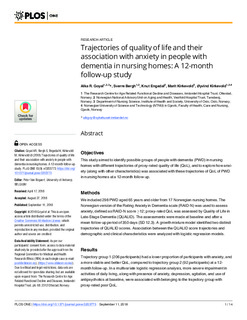| dc.contributor.author | Goyal, Alka Rani | |
| dc.contributor.author | Bergh, Sverre | |
| dc.contributor.author | Engedal, Knut | |
| dc.contributor.author | Kirkevold, Marit | |
| dc.contributor.author | Kirkevold, Øyvind | |
| dc.date.accessioned | 2019-08-30T10:47:54Z | |
| dc.date.available | 2019-08-30T10:47:54Z | |
| dc.date.created | 2018-09-14T09:56:05Z | |
| dc.date.issued | 2018 | |
| dc.identifier.citation | PLoS ONE. 2018, 13:e0203773 (9), 1-14. | nb_NO |
| dc.identifier.issn | 1932-6203 | |
| dc.identifier.uri | http://hdl.handle.net/11250/2611834 | |
| dc.description.abstract | Objectives
This study aimed to identify possible groups of people with dementia (PWD) in nursing homes with different trajectories of proxy-rated quality of life (QoL), and to explore how anxiety (along with other characteristics) was associated with these trajectories of QoL of PWD in nursing homes at a 12-month follow-up.
Methods
We included 298 PWD aged 65 years and older from 17 Norwegian nursing homes. The Norwegian version of the Rating Anxiety in Dementia scale (RAID-N) was used to assess anxiety, defined as RAID-N score ≥12; proxy-rated QoL was assessed by Quality of Life in Late-Stage Dementia (QUALID). The assessments were made at baseline and after a mean follow-up period of 350 days (SD 12.3). A growth mixture model identified two distinct trajectories of QUALID scores. Association between the QUALID score trajectories and demographic and clinical characteristics were analyzed with logistic regression models.
Results
Trajectory group 1 (206 participants) had a lower proportion of participants with anxiety, and a more stable and better QoL, compared to trajectory group 2 (92 participants) at a 12-month follow-up. In a multivariate logistic regression analysis, more severe impairment in activities of daily living, along with presence of anxiety, depression, agitation, and use of antipsychotics at baseline, were associated with belonging to the trajectory group with proxy-rated poor QoL.
Significances
This study reveals that anxiety is associated with proxy-rated poor QoL of PWD at a 12-month follow-up. Efforts should be made to identify anxiety among nursing home residents with dementia to initiate treatment. | nb_NO |
| dc.language.iso | eng | nb_NO |
| dc.publisher | Public Library of Science | nb_NO |
| dc.relation.uri | https://journals.plos.org/plosone/article/file?id=10.1371/journal.pone.0203773&type=printable | |
| dc.rights | Navngivelse 4.0 Internasjonal | * |
| dc.rights.uri | http://creativecommons.org/licenses/by/4.0/deed.no | * |
| dc.title | Trajectories of quality of life and their association with anxiety in people with dementia in nursing homes: A 12-month follow-up study | nb_NO |
| dc.type | Journal article | nb_NO |
| dc.type | Peer reviewed | nb_NO |
| dc.description.version | publishedVersion | nb_NO |
| dc.source.pagenumber | 1-14 | nb_NO |
| dc.source.volume | 13:e0203773 | nb_NO |
| dc.source.journal | PLoS ONE | nb_NO |
| dc.source.issue | 9 | nb_NO |
| dc.identifier.doi | 10.1371/journal.pone.0203773 | |
| dc.identifier.cristin | 1609429 | |
| dc.description.localcode | © 2018 Goyal et al. This is an open access article distributed under the terms of the Creative Commons Attribution License | nb_NO |
| cristin.unitcode | 194,65,70,0 | |
| cristin.unitname | Institutt for helsevitenskap Gjøvik | |
| cristin.ispublished | true | |
| cristin.fulltext | original | |
| cristin.qualitycode | 1 | |

